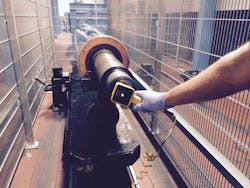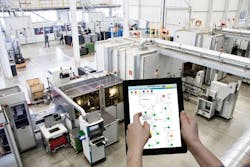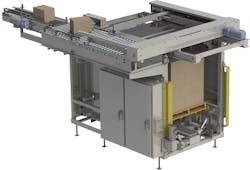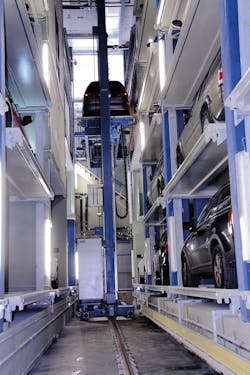Dan Hebert is senior technical editor for Control, Control Designand Industrial Networking. Email him at [email protected].
In the beginning, machines were either islands of automation or linked to other machines in a production line via a few hardwired I/O. Then came machine-to-machine communication, usually via some type of digital data link. Now, more and more machines are linked to IT systems in many different ways for a variety of purposes.
Connecting machines to IT systems provides a number of benefits for machine builders and their customers. In the past, this access was often hard to implement due to proprietary communication protocols and closed systems. But now, open systems are the rule, particularly when the controller or the HMI is PC-based. These open systems and their standard communication protocols are making it ever easier to connect machines to IT systems.
OEMs, their customers and their suppliers can find benefits in connecting machines to IT systems. “Linking our tools and machines to IT systems allows our customers to customize data acquisition systems to meet their specific needs and to monitor machine performance remotely and compare performance among multiple machines,” says Doug Putnam-Pite, director of software development, Owens Design in Fremont, California. Owens makes high-speed material handling equipment for the semiconductor, disk drive, solar and consumer electronics industries.
“Linking machines to IT systems provides a great deal of information about how and where to deploy idle machines, along with information about when it is safe to continue or when there is a need to stop a machine or process,” points out Richard Clark, Wonderware InduSoft technical specialist, Schneider-Electric. “This information can be used to increase uptime, reduce operating costs, and provide the ability to make decisions remotely. Interfacing with ERP and using JIT or other ordering or supply chain techniques can help match machine production to process line needs.”
Rockwell Automation also sees benefits. “Connecting smart machines to enterprise-wide IT systems helps end users view their processes as a whole,” observes Christopher Zei, vice president, global industry group, Rockwell Automation. “They can readily access information to make better decisions and improve plant efficiency. Preventive maintenance, diagnostics and issue resolution can all happen more quickly, decreasing downtime and reducing maintenance costs.”
Also read: The machine builders’ guide to remote monitoring
Improved quality is a goal of most every production process, and sending data from machines to higher-level QA/QC software for analysis contributes to this effort. Inventory control is often implemented by connecting parts and machines to ERP and other IT systems. And remote access to machines is a feature used by many OEMs and their customers, and it often involves linking machines via various types of IT systems, often cloud-based (Table 1).
Reasons to Link Machines to IT Systems
- Optimize operation of each machine
- Coordinate operation among machines
- Production planning
- Inventory control
- Quality analysis and control
- Remote access
Plants are now able to more easily establish and maintain links between machines and IT systems because of open communication hardware and software standards. Much of this openness is due to the PC, making machines with PC-based controls a natural fit for integration to IT systems.
PCs provide easy integration
Echo Hill Automation, based in Beamsville, Ontario, manufactures centerless grinding machines. It uses PC-based HMI and control systems from Beckhoff Automation and installs quality control software on the same PC used for control, greatly simplifying the required integration effort.
Albion Minerals is a vitamin and mineral supplement manufacturer based in Clearfield, Utah. It provides links from the plant-floor machines to its IT systems in one of two ways: through PC-based HMIs or through Opto 22’s groov, an embedded communications server.
“Opto 22’s groov box allows us to watch and control our processes remotely through any smart phone or tablet,” explains Jim Sciarini, an associate engineer at Albion. “Any employee with clearance has the ability to view many of the HMI screens we have available, up to controlling complete operations. This has proven itself invaluable to us for monitoring sensitive processes. It’s also a wonderful diagnostic tool if you’re not by a control screen, which describes our situation, as we have several pieces of equipment a couple of floors away from the controller. With groov, the technician can physically be by the equipment and control it via smartphone,” adds Sciarini.
Also read: PC enables links to QC software
Owens Design often provides its tools and machines with a PC-based HMI, which is used to link to IT systems via OPC. PCs and related hardware are making it easier to connect machines to IT systems, but others prefer to connect directly from the PLC to IT systems.
PLCs join the party
Duane Gilson is a control engineer at Quad/Graphics, headquartered in Sussex, Wisconsin, which uses PLCs to link cylinders used in printing machines and processes to an inventory control system. “The automation of our cylinder storage and retrieval system in Franklin, Kentucky, was instrumental in reducing processing time, increasing throughput, eliminating errors and improving safety,” notes Gilson.
“From the time an operator inbounds a cylinder into the storage system until it is processed and sent back to the printing press, an RFID system tracks the cylinders. This has eliminated cylinders being lost due to operator error, incorrect cylinders being engraved or wrong jobs being loaded into the engravers,” add Gilson.
“The data from the RFID readers also tracks the cylinder carts to make sure the cylinders are placed on the correct carts for transport,” continues Gilson. “This prevents accidents when cylinders are misplaced on carts. The control system reads the status of the equipment to track the cylinder movement, loads the correct job into the engravers, controls inventory and ensures the correct cylinders are brought out to both the imaging department and the printing presses.”
Figure 1: A handheld scanner is used to read RFID data from a tag affixed to this print cylinder, allowing it to be tracked throughout the plant.
Source: Turck
Quad/Graphics’ inventory control system starts with RFID scanners from Turck, which it uses to scan print cylinder Turck RFID tags (Figure 1). These scanners are connected to a PLC-based Horstmann cylinder storage and retrieval system. Quad/Graphics’ automation controls system (ACS) uses OPC to read status bits from the PLCs and to write commands to the PLCs. The commands can be to pick/place cylinders, reset faults, abort task and retrieve/store cylinders. The ACS is a custom IT application running on a server. Users install and run a client application on the laptop or PC to interface to the ACS.
Improved data analysis
Another company using PLCs to communicate with IT systems is Stiwa Automation. It uses its manufacturing software to collect data from PLCs and other controllers installed in automated feeding, packaging and transport systems, as well as assembly and process modules (Figure 2).
Figure 2: Stiwa sends production data from its machine controllers to IT systems for analysis, optimizing operation.
Source: STIWA
Stiwa engineers use MatLab to analyze the large amounts of collected production data, allowing them to calculate time-optimal trajectories for machinery, reduce cycle times for production systems and increase output.
Also read: How OPC aids integration
Every eight seconds, a typical Stiwa system collects more than 9 megabytes of raw production data in 150,000 data sets capturing noise, torque and other machine measurements. This data must be filtered and processed to identify appropriate tolerances, modify processes or compute time-optimized tracks for robots or flexible transfer systems.
In the past, Stiwa engineers wrote data analysis algorithms in low-level languages such as IEC 61131-3 structured text for PLCs. This approach was slow, and it became unworkable as the algorithms grew more complex.
So, Stiwa engineers now import machine and product data into MatLab and then filter, resample and visualize the data to identify problems and optimization opportunities. Working in MatLab, the engineers develop algorithms to automate data analysis and plan time-optimal trajectories for robotic components.
“To be effective, our algorithms must analyze a huge amount of data in near real-time,” says Martin Werner, software tools development engineer at Stiwa. “We achieved this high level of performance by optimizing our MatLab algorithms.”
Machine builders have been using remote access for decades, but tying machines to IT systems can improve these communications by offering faster implementation, better security and more widespread access.
IT improves remote access
Figure 3: Cloud-based remote access allows Premier Tech Chronos to monitor, maintain and service each of their machines via an Ethernet port on the PLC connected to the cloud via the Internet.
Source: Premier Tech Chronos
Premier Tech Chronos is headquartered in Quebec and delivers bag packaging equipment and complete end-of-line packaging solutions (Figure 3). The company recently redesigned the control system on its SPLX Compact palletizer to improve operation and remote access.
“Typically, a customer would alert us to a performance issue, and we could access their equipment online and troubleshoot the problem,” says Louis Brochu, engineering after-sales manager, Premier. “But we wanted to provide a service that would be more proactive and better maintain the health of their system.”
Figure 4: Stopa remotely accesses over a thousand of its material handling machines located at customer sites via a VPN connection from each machine to its customer service IT system.
Source: STOPA
Working with Rockwell Automation, Premier developed a cloud-enabled remote monitoring solution that could be applied not only to the SPLX Compact palletizer, but to all of the company’s equipment. The CompactLogix PLC on the palletizer connects to the Internet via its Ethernet port. Connection to the cloud is per modular cloud information integration (MCCI) standards, and it’s powered by Microsoft Azure cloud services. The Azure platform stores and processes the collected data, and allows remote viewing of pertinent machine parameters via any Web browser.
“Through this cloud-enabled solution, we can continuously monitor a wide range of performance parameters regarding machine components and overall cycle times,” notes Brochu. “Based on the results, we can determine the optimal time for maintenance and also improve overall equipment effectiveness.”
Another type of remote access solution is used by Stopa Anlagenbau, one of Europe’s providers of automatic storage and retrieval systems (Figure 4). Stopa had been using a modem-based service solution for remote support, and establishing the connection and the exchange of extensive program files with the Siemens Step 7 PLC required 20 minutes. With the conversion to an mGuard virtual private network (VPN) technology from Innominate, establishing the connection was reduced to just a few seconds.
“The connection time for remote service is an important variable, because the faster we can help the customer, the more cases the support team can attend to,” says Ettore Caurla, customer service, Stopa.
The machine operator must first enable the remote service connection with a VPN hardware switch that can only be initiated from the plant operator’s network, allowing an operator to always maintain control over remote access.








